
My tastes in games have changed many times over the years. There are times when I obsessively play fighting games. At other times, I will want to dig into an RPG. And still other times, a hack-and-slash game is just what I need to get my gaming fix.
But throughout the years, since 1997 there has been one constant: my all time favorite video game, Final Fantasy VII.
There is no game out there which has meant more to me than Final Fantasy VII, not by a long shot. I have spent more time, on this one game, by far, than on any other game I’ve ever played, exploring its secrets inside and out. There is no game which has so profoundly influenced my identity as a gamer. There is no other game that immersed me so fully in its world and the characters that inhabit it.
Final Fantasy VII has been one of the most polarizing games ever made. No other video game has been so fiercely debated in magazine articles and on Internet forms. Its supporters, myself included, love the very same things its detractors hated about it.
Final Fantasy VII truly defined me as a gamer. Final Fantasy VII was not the first RPG I’d ever played, nor was it the first JRPG I’d ever played. It was not even the first Final Fantasy game I’d ever played (that was Final Fantasy VI, three years earlier). But Final Fantasy VII represented a paradigm shift in my gaming habits, getting me hooked on not just RPGs, but SRPGs and even survival horror as well.
That I even bought a PS1 at all was itself a profound change of direction for me. Although I also played arcade and PC games, ever since the mid-80’s I’d always accepted Nintendo’s iron grip on video gaming without question, even though I disliked Nintendo of America’s “we know best” attitude towards gamers enough to pass on the Super NES until 1994, when Nintendo finally stopped bowdlerizing SNES games.
I got a Nintendo 64 and Super Mario 64 for Christmas in 1996. Super Mario 64 was the most impressive game I’d ever seen at that time, and I played the hell out of it. Unfortunately, it became clear that the N64 was essentially a TV plug-in for Super Mario 64 that just happened to have a few other games, most of them terrible. Even Rare wasn’t doing it for me. Meanwhile, FFVII looked better and better with every passing month, and Nintendo’s attempts to prop up the N64’s anemic library looked more and more hollow. Sony’s over-the-top ads for FFVII, ran in magazines and on TV shows where video games had never before appeared, only piqued my interest further.
I admired the sheer ambition and scope of Final Fantasy VII. From the very beginning, Mr. Sakaguchi, Mr, Kitase, and Mr. Nomura had big dreams for Final Fantasy VII. They wanted to create the greatest spectacle ever seen in a video game, and one which would be remembered long after the initial glow of its release had faded. But Nintendo’s decision to stick with cartridges left them cold. They did not want FFVII fettered by the computational and memory limitations of the Nintendo 64… or by Nintendo’s heavy-handed paternalism. It is for these reasons that Square severed its long-time relationship with Nintendo in favor of Sony, which promised better support and greater artistic freedom for everyone, even going so far as to close down their original US office in Washington and moving to California, where SCEA is headquartered.
The environment that created Final Fantasy VII was a developer’s dream, combining a bottomless budget with a relatively liberal creative environment. The sky was the limit, and FFVII’s developers threw everything but the kitchen sink into FFVII, both creatively and artistically. You journeyed through glitzy cities, squalid yet festive slums, quaint villages and through savage, beautiful forests, caves, and snowy mountains. You visited an amusement park which was almost a video game in itself. FFVII’s ambitious design is summed up by iconic images of the game’s first location, the vast, sprawling city of Midgar. The battle effects were exaggerated and spectacular, and the summons were impressive, nor were they overly long as in later games. Beyond the traditional RPG, Square offered simple arcade-style minigames. I could tell the designers had a lot of fun making this game, and it showed.
With Final Fantasy VII, Square succeeded where Sega, Atari, SNK, NEC, and other competitors had failed: they broke Nintendo’s iron grip on the video game industry. Nintendo’s stock plunged the day Square announced Final Fantasy VII’s platform as the PS1. Until then, Sony had been struggling just to compete against the Saturn, despite offering more developer support and better royalties than either Nintendo or Sega. However, the Saturn, even though it was leading in Japan at that time, was still not selling well enough to prove itself an adequate alternative to the Nintendo 64 for most companies, and the Saturn’s weak US sales further deterred developers. Shortly after Square made the PS1 FFVII announcement, its rival Enix likewise moved development of Dragon Quest VII to the PS1 from the Super Famicom. Sales of the PS1 rose rapidly after this announcement, and the PS1 suddenly became a viable, attractive alternative to Nintendo, which had angered developers by choosing to stick with expensive, low-capacity cartridges over the cheaper, higher-capacity CD-ROM format. As a result, Nintendo spent the 5th generation largely alienated from the rest of the industry.
Final Fantasy VII was an expression of the anxieties of the times. In place of all the medieval kingdoms trying to conquer the world typical of traditional fantasy RPGs, Final Fantasy VII offered something that was quite new at the time for an antagonist organization: the Shinra Electric Power Company. On the surface, Shinra was yet another “evil empire”, but an examination of the times that produced Shinra showed that the corporation was very much a commentary on the economic environment in both Japan and the United States.
At the time Final Fantasy VII was being made, the Japanese economy, after thirty years of robust growth, had gone bust thanks to the price asset bubble that at its peak had for one day in 1995 made Japan’s economy larger than the American economy for the first time since the 1870s. The ensuing market correction resulted in a period of economic stagnation known in Japan as the “Lost Decade.”
The Japanese economy, and to a large degree its political system, are dominated by massive business consortiums known as keiretsu, although Americans popularly call them by their pre-WWII term, zaibatsu. A legacy of the Tokugawa shogunate, the keiretsu have huge operations in multiple industries and control all the means of production and distribution of their products. These business operations are financed by huge banks – and even today, many of the world’s largest banks are Japanese banks. Examples of keiretsu are Mitsubishi, Mitsui, Sumitomo, and Sony. Because of the size of the banks funding them, almost nothing was out of reach for a keiretsu, including exerting a remarkable degree of control over the Japanese government. One of the most telling signs of how pervasive corporate culture is in Japanese society is in Japan’s professional baseball league. Japanese baseball teams are usually named not after their host cities, but their corporate owners, such as the Yomiuri (Japan’s largest newspaper) Giants in Tokyo, the Fukuoka Softbank Hawks, the Hokkaido Nippon Ham Fighters, and others. Think about having sports teams in the USA like the Microsoft Seahawks, Nintendo Mariners, Kraft Patriots, or Turner Braves!
In the US, anxiety over certain large corporations was growing as well. Wal-Mart, the world’s largest retailer, was becoming notorious for moving into rural American communities, driving out local competitors, and then closing up shop due to poor sales, leaving whole counties economically devastated. Microsoft’s near-absolute control of the PC market, illustrated by the battle between Netscape and MS’s Internet Explorer, was subjecting it to scrutiny from the US Department of Justice and European regulators, culminating in United States vs. Microsoft Corporation. Prior to this was the specter of high-profile industrial disasters like Three Mile Island and Love Canal. Corporations have created powerful lobbies to ensure continued cooperation from Congress, often over the will of the voting public.
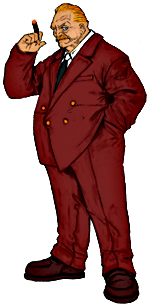
By using a cheap, easily exploited source of energy, Mako energy, Shinra had become so pervasive in the lives of the people that conventional governments had ceased to exist. Shinra took over all functions of government, including legislation, finance, as well as police and military operations. All of this came at terrible cost to the environment, as Shinra’s Mako energy was the very life force of all creation, and Shinra was in reality burning human souls in order to create electrical power. Shinra also carried out unethical scientific and social experiments on the populace, showing no regard for human life, including the Jenove Project that ultimately produced Sephiroth. Despite this, Shinra’s power was largely unchallenged. Mako energy had made people’s lives very easy, giving the contented population little reason to go against their perceived benefactor. Dissenters like AVALANCHE were swiftly punished by Shinra’s police and military services, and portrayed in the Shinra-owned media as terrorists to ensure public support for Shinra.
Shinra was probably most closely modeled on the Tokyo Electric Power Company, or TEPCO – the same company which operates the Fukushima nuclear power complex damaged by the March 11 earthquake and tsunami, which is known to have wide influence in the Japanese government. Several of Final Fantasy VII’s cities, including Corel and Gongaga, were laid to waste by explosions at Shinra’s Mako reactors. It’s also possible that Shinra was a jab at Nintendo, which was experiencing a huge backlash from the Japanese development community over its decision to use cartridges as well as years of heavy-handed policies towards third parties.
I loved the Materia system. Though not everyone liked it, I felt like it added a lot to the game experience. It let me customize my characters any way I wanted, plus unlocking the high-end spells and abilities was rewarding. It felt like a real treasure hunt. One of the recent trends in RPGs I have never cared for is the ongoing trend towards vendor trash collect-a-thons, and it gets frustrating constantly trying to scavenge ten lizard skins and eight dragon hearts from random drops in battle.
The Materia system was designed for old-school players and beginners alike. The broad customization and ability to mix and match abilities with the Command materia was designed for the Japanese fanbase, for whom FFV was much more popular than FFVI. Since abilities beyond physical attacks and limit breaks were keyed to the Materia instead of to the characters, you could experiment with different combinations to see what you liked. The “linking” Materia system seemed underutilized at first, with only the “All” materia available during the first couple of chapters in the game, but later on, if you understood how to use blue materia, you could create some very effective gambits in battle that would be godsends against the game’s tougher enemies.
Furthermore, the Materia system was set up in such a way as to make power come with a price. The materia, weapons, and armor all tended to be double-edged swords, as Cloud himself says. Magic and summon materia gave you a lot of spells, but also carried penalties to the user’s HP and strength – and the more powerful the materia, the heavier the stat penalty. Stat penalties also stacked. A character loaded down with magic and summons would become a “glass cannon” – able to deal a lot of damage but unable to withstand a lot of damage. The materia system also caused me to rethink my approach to upgrading weapons and armor. Simply upgrading attack and defense is not always the surest path to success. A weapon or armor might be weak stat-wise but give double or triple bonuses for any AP received to any materia placed in its slots. A piece of equipment might have more materia slots, but none of them linked so as to disable support materia. A seemingly powerful weapon could be crippled by having no AP growth for any materia placed in it. A weapon or armor that would have been a great find in any other Final Fantasy game might be rendered worthless by not having any materia slots at all, severely limiting the character’s magic and command capabilities. The game’s most powerful weapons all offered eight linked slots in addition to their attack abilities (which were modified by various visible and hidden states), but zero materia growth, while double- and triple-growth weapons tended to have fewer slots and fewer linked slots.
Final Fantasy VII’s difficulty and rewards were very well-balanced. Prior to FFVII, Square had struggled to find the right balance of challenge and reward for Final Fantasy. For the first five games, they tended to err on the side of challenge. However, this resulted in punishing bosses as well as sharp spikes in difficulty, where inadvertently journeying into a new area of the world map could result in the party being wiped out by random monsters which were too powerful. This was most infamously evident in FFII with its unusual system of leveling and the fact that it was impossible to escape from more powerful random enemies, but was present in all of the first five games to a degree. Japanese fans liked this level of challenge, but Americans were frustrated by some of the harder fights as well as the grinding required to get up to speed. In Japan, FFIV released in a “hardtype” for series veterans and a heavily stripped-down “easytype” for children. The US version was a port of the “easytype” version. Final Fantasy VI, by contrast, was a bit too easy, with heavily overpowered player characters, gold given so generously as to be as worthless as Monopoly money, and powerful spells and weapons being given out very early. Japanese FF fans were displeased by FFVI’s difficulty.
With Final Fantasy VII, Square aimed to reconcile the story/cinematic approach that Americans liked with the degree of challenge and customizability that the Japanese wanted. The difficulty curve was reasonable, with the monsters growing in power proportionate to your party’s expected progress and none of the sudden difficulty spikes that plagued pre-VI games. Materia and more powerful weapons were parcelled out at a reasonable pace; monsters yielded enough gold to ensure you could buy basic staples, but not so much as to make money seem worthless. AP was doled out at a rate which allowed your materia to grow powerful enough to match your enemies. The game was reasonably challenging, yet no grinding is necessary unless you’re like me and absolutely have to unlock every possible spell and special ability in the game. For the real masochists, FFVII also offered two optional super-bosses with a million HP, a bonus that was initially offered only to Americans before being added to an “International” version released in Japan a year or so later.
The battle system still entertains me after all this time. Square decided to show off their newfound technological prowess in Final Fantasy VII’s battles, and at the time, FFVII battles were among the best pieces of video game technology around. This showed to greatest effect in summons and limit breaks. While Square would be criticized for making spell and summon animations too long in later games, particularly FFVIII, FFVII’s spells and summons were just of the right length to be impressive without being annoying, and the game didn’t rely on summons and limit breaks as heavily as later games did. But it wasn’t just the summons that were awesome. The game also had more subtle touches like enemies that would just make threatening gestures at party members, which was something not seen in a lot of games of that time.
Final Fantasy VII’s soundtrack brought international recognition to composer Nobuo Uematsu. Mr. Uematu’s compositions were as much a part of Final Fantasy VII’s narrative as the visuals and the dialogue. He intimately understood how his music helped set the mood for every scene in the game. FFVII’s soundtrack is a major departure from Uematsu’s traditional, high-fantasy RPG soundtracks inspired by Dragon Quest composer Koichi Sugiyama. He chose to infuse many modern musical influences into FFVII’s soundtrack, including rock and roll and jazz, to fit with the game’s more contemporary theme compared to the medieval settings of the first six games. Uematsu’s single most famous composition is “One-Winged Angel”, the song that, complete with vocals, plays during the final battle with Sephiroth.
http://www.youtube.com/watch?v=6UARM4q7hHU
Final Fantasy VII had some of the most memorable heroes and villains in video gaming history. As with other aspects of this game, FFVII’s main characters tended to polarize gamers. But whether you loved them or hated them, there is no doubt of the impact the main FFVII cast had not only on video games, but on popular culture in both Japan and the United States.
FFVII is often credited, somewhat unfairly, for starting a trend in RPGs for super-powered teenagers and leather clothes with too many zippers. FFVII had neither of these things. All of its main characters were save for Yuffie (and maybe Red-XIII, if you believe Bugenhagen’s assessment of relative ages) were adults old enough to drink legally. All of them were either former military or police officers, or were street fighters hardened by life on the mean streets of Midgar.
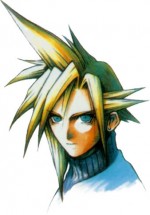 Cloud, with his oversized Buster Sword, striking blue eyes, and wild, unmanageable hair – a trait specifically designed into him by illustrator Tetsuya Nomura for the technology available to Square at the time – was a memorable hero. Seemingly uncaring about anything except his next paycheck, Cloud is deeply conflicted inside, and this internal conflict is masterfully played by Sephiroth in order to weaken Cloud’s will and make him a willing slave of Sephiroth. As he comes to terms with the conflict within him, between the cocky, aloof persona he projects to the outside world and the scared boy longing for acceptance within him, Cloud becomes a much stronger person and a great leader for AVALANCHE as they battle Sephiroth and Shinra.
Cloud, with his oversized Buster Sword, striking blue eyes, and wild, unmanageable hair – a trait specifically designed into him by illustrator Tetsuya Nomura for the technology available to Square at the time – was a memorable hero. Seemingly uncaring about anything except his next paycheck, Cloud is deeply conflicted inside, and this internal conflict is masterfully played by Sephiroth in order to weaken Cloud’s will and make him a willing slave of Sephiroth. As he comes to terms with the conflict within him, between the cocky, aloof persona he projects to the outside world and the scared boy longing for acceptance within him, Cloud becomes a much stronger person and a great leader for AVALANCHE as they battle Sephiroth and Shinra.
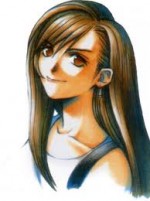 Tifa is one of the best-known video game heroines ever, both for her strong personality and her status as a video gaming sex symbol. She is the biggest badass in the game, kind of like the female equivalent of Chuck Norris. She demolishes her enemies with 7-hit chain combos. She threatens to neuter the local pimp. She’s not afraid to get up in anyone’s face. Even in a rare moment of vulnerability, she’s still Cloud’s rock of solidarity, believing in him when everyone else has pegged him as a lost cause.
Tifa is one of the best-known video game heroines ever, both for her strong personality and her status as a video gaming sex symbol. She is the biggest badass in the game, kind of like the female equivalent of Chuck Norris. She demolishes her enemies with 7-hit chain combos. She threatens to neuter the local pimp. She’s not afraid to get up in anyone’s face. Even in a rare moment of vulnerability, she’s still Cloud’s rock of solidarity, believing in him when everyone else has pegged him as a lost cause.
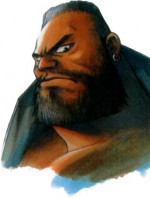 Barrett, the series’ first black main character, was probably the most complex character in the game. His characterization by FFVII localization specialist Richard Honeywood is the fore-runner of that of Augustus “Cole Train” Cole from Gears of War. He is a capable leader of AVALANCHE and a loving father to Marlene. Barrett believes in the cause he’s fighting for, even though he is aware of his grudge against Shinra for the loss of his family. Towards the end, however, Barrett also realizes the potential consequences of his sometimes rash actions on people and that Shinra, whatever its faults, has also done a lot of good for people. He also reminds me fondly of one of my oldest and closest friends.
Barrett, the series’ first black main character, was probably the most complex character in the game. His characterization by FFVII localization specialist Richard Honeywood is the fore-runner of that of Augustus “Cole Train” Cole from Gears of War. He is a capable leader of AVALANCHE and a loving father to Marlene. Barrett believes in the cause he’s fighting for, even though he is aware of his grudge against Shinra for the loss of his family. Towards the end, however, Barrett also realizes the potential consequences of his sometimes rash actions on people and that Shinra, whatever its faults, has also done a lot of good for people. He also reminds me fondly of one of my oldest and closest friends.
 Red XIII, real name Nanaki, is a wolf-like creature with flaming red fur who serves as a source of knowledge about the workings of the planet’s spiritual energy owing to his tribe’s intimate connection with the planet. Although he is the oldest of the party members and is very quiet and thoughtful, due to the longevity of his tribe, he is still considered an adolescent and has much growing up to do, physically and emotionally.
Red XIII, real name Nanaki, is a wolf-like creature with flaming red fur who serves as a source of knowledge about the workings of the planet’s spiritual energy owing to his tribe’s intimate connection with the planet. Although he is the oldest of the party members and is very quiet and thoughtful, due to the longevity of his tribe, he is still considered an adolescent and has much growing up to do, physically and emotionally.
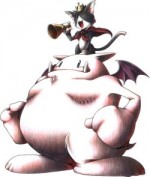 Cait Sith, a Puss-n-Boots doll riding atop a giant stuffed Moogle, was a somewhat baffling choice of character… until you played though a lot of the story. It turns out he’s a spy for Shinra, but seeing Cloud, Tifa, Barrett, and Aerith risk their lives to help a population that will never see them as heroes makes him question his already shaken faith in his employer. Eventually, the player will learn exactly what Cait Sith’s role in Shinra is and how it relates to them.
Cait Sith, a Puss-n-Boots doll riding atop a giant stuffed Moogle, was a somewhat baffling choice of character… until you played though a lot of the story. It turns out he’s a spy for Shinra, but seeing Cloud, Tifa, Barrett, and Aerith risk their lives to help a population that will never see them as heroes makes him question his already shaken faith in his employer. Eventually, the player will learn exactly what Cait Sith’s role in Shinra is and how it relates to them.
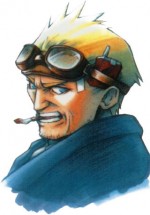 Cid Highwind, the series’ Cid, was probably one of the more controversial aspects of the game. Like all FF games, he is an airship pilot. Embittered by Shinra closing down its space program after an aborted launch, which would have made Cid the first human in space, he swears and drinks to excess. Shera, the engineer whom he blames for the failure of his maiden space voyage, seeks penance by devoting her life to Cid, but he treats her like dirt, until he discovers that she probably saved him from being killed in an explosion in space. He was one of the first real attempts at making a less-than-perfect video game hero.
Cid Highwind, the series’ Cid, was probably one of the more controversial aspects of the game. Like all FF games, he is an airship pilot. Embittered by Shinra closing down its space program after an aborted launch, which would have made Cid the first human in space, he swears and drinks to excess. Shera, the engineer whom he blames for the failure of his maiden space voyage, seeks penance by devoting her life to Cid, but he treats her like dirt, until he discovers that she probably saved him from being killed in an explosion in space. He was one of the first real attempts at making a less-than-perfect video game hero.
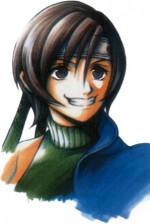 Yuffie serves as the party’s comic relief, a young materia-stealing ninja (or so she claims), who eventually robs the party blind of all of its materia. The reason she wants the materia, it turns out, is so she can restore her homeland of Wutai to its former glory after the town was devastated in a war with SOLDIER (detailed in FF: Crisis Core on PSP). One of the running gags of the series is her tendency to get motion sickness on ships and aircraft. Along with Vincent, she is one of the game’s two optional “secret” characters, one who will not automatically join the party by following the story.
Yuffie serves as the party’s comic relief, a young materia-stealing ninja (or so she claims), who eventually robs the party blind of all of its materia. The reason she wants the materia, it turns out, is so she can restore her homeland of Wutai to its former glory after the town was devastated in a war with SOLDIER (detailed in FF: Crisis Core on PSP). One of the running gags of the series is her tendency to get motion sickness on ships and aircraft. Along with Vincent, she is one of the game’s two optional “secret” characters, one who will not automatically join the party by following the story.
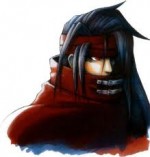 Vincent, a former member of the Turks, FF7’s recurrent “Team Rocket” bad guys, has sealed himself from the outside world, torturing himself of memories of the woman he loved, whom he believes (mistakenly) that he sacrificed to Shinra’s Jenova Project that ultimately produced Sephiroth. Though he was a secret character, he became one of the most popular characters in the series, enough to warrant his own game. His limit breaks allow him to transform into monsters who are callbacks to the previous games in the Final Fantasy series, including Chaos, the villain of the very first Final Fantasy game.
Vincent, a former member of the Turks, FF7’s recurrent “Team Rocket” bad guys, has sealed himself from the outside world, torturing himself of memories of the woman he loved, whom he believes (mistakenly) that he sacrificed to Shinra’s Jenova Project that ultimately produced Sephiroth. Though he was a secret character, he became one of the most popular characters in the series, enough to warrant his own game. His limit breaks allow him to transform into monsters who are callbacks to the previous games in the Final Fantasy series, including Chaos, the villain of the very first Final Fantasy game.
http://www.youtube.com/watch?v=IOsQvHLauYE&feature=related
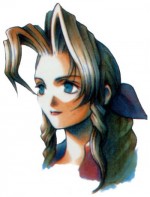 Aerith, the heroine of the game. Cloud meets her at the outset while she is selling flowers in the slums of Midgar, and fate brings him together with her later on. Aerith seems to have a rather frivolous nature, and her attentions to Cloud inflame the jealousy of Tifa. It turns out her flighty nature masks her anxieties over a mission that she knows will almost certainly cost her her life, yet is a sacrifice she must make for the good of humanity, similar to a later FF heroine, Yuna.
Aerith, the heroine of the game. Cloud meets her at the outset while she is selling flowers in the slums of Midgar, and fate brings him together with her later on. Aerith seems to have a rather frivolous nature, and her attentions to Cloud inflame the jealousy of Tifa. It turns out her flighty nature masks her anxieties over a mission that she knows will almost certainly cost her her life, yet is a sacrifice she must make for the good of humanity, similar to a later FF heroine, Yuna.
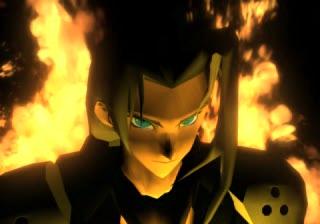
And finally, the villain of the piece, Sephiroth. A product of Shinra’s twisted genetic engineering, Sephiroth is as much a victim as a villain. He went into SOLDIER with the best of intentions, but fell victim to the influence of the blood of Jenova coursing in his veins, causing him to do terrible things. Sephiroth is my favorite villain of all time, not just because of who he is, but because of the way Square presented him. Every time he showed up, you knew bad things were about to happen. He was portrayed as a malevolent supernatural force with very human, if very twisted, motivations. As a game player, I felt fully the psychological torture Sephiroth inflicted upon Cloud, to the point where he made Cloud doubt his very humanity. Among the best moments in the game are Sephiroth walking through the flames of Nibelheim, which he burned to the ground in a fit of insanity, and of course, the famous scene of Aerith’s death. To me, that was the single most powerful scene I’ve ever seen in a video game – the cinematography, music, and sounds were perfect. I wouldn’t even want this scene remade in HD.
The distinctive looks of the heroes and villains made them iconic video game characters. Not only that, but their popularity transcended both shores of the Pacific. There are few among American and Japanese gamers from the 1990’s who do not recognize Cloud Strife, his famous Buster Sword, or the silver-haired, green-eyed Sephiroth. For all intents and purposes, Cloud was the true mascot of Sony’s upstart PlayStation game console.
A more personal reason why Final Fantasy VII is my favorite video game of all time: Now that I think of it, this part reads a lot like Tifa restoring Cloud’s memories midway through Disc 2. But I digress.
I’ve suffered from anxiety disorders for a long time, and still do. When I was a teenager, I was pretty unsocial because of this. The only time I felt at ease around people other than family was at the video arcade, in fact. My anxiety problems even led me to drop out of school. My folks didn’t know how to help me, and I sure didn’t know how to help myself. I made money doing odd jobs but was otherwise stuck without any clear sense of direction or purpose.
When Final Fantasy VII came out, I saw the TV ads and the store demos and I was hooked. Only problem was, I had no PlayStation to play it on. I bought the game anyway. This provided me with some much needed motivation and direction.
I went out and secured a job at Wendy’s. I promised myself that if I stuck it out, the first thing I’d buy with my first paycheck would be a PlayStation to play FFVII on. Two weeks later I had my brand-new PS1 in hand and was driving home so fast I’m surprised I wasn’t leaving flaming tire marks on Interstate 35. Never had I enjoyed opening up a new video game console so much. For the next couple of weeks, I would come into work very sleepy. I deemed sleep a necessary sacrifice for the greater good of exploring all of Final Fantasy VII’s secrets late into the night.
I’d made it. I held onto my job even once I had my PS1, and spent the next year amassing a very fine collection of PS1 games I still own now while failing to accumulate any kind of significant savings secondary to said PS1 collection. Eventually, I went to college (starting my freshman year with what was technically a ninth grade education!), became a nurse, got married, and started writing about gaming. Someday, I will hopefully be able to build my own big, beautiful RPG. All of this because I wanted to experience an adventure that “could never be done in a major motion picture,” to quote one of Sony’s overly enthusiatic ads for FFVII.
Don’t get me wrong. Even without this little bit of emotional attachment, Final Fantasy VII would still be my favorite game, for all the reasons I listed above. This is the one game I will pull out and play once a year. I’ll still have just as much fun with it as I did way back whem, and ever once in awhile, I’ll manage to find something new, that I haven’t seen before. Final Fantasy VII’s place on this list, and in my heart, was secured before I recalled these memories of playing a video game I earned for myself all those years ago.
So there you have it. After nearly a year, my list of all-time video game favorites is completed with Square’s 1997 masterpiece. I doubt that there will ever be a game that comes close to Final Fantasy VII in the sheer enjoyment I’ve gotten (and still get) from this title, let alone a game that surpasses it. I replay FFVII once a year, and for 2 weeks of every year, I become the fresh-faced kid I was back then, lost in the wonder and spectacle that Square spent three years and millions’ of dollars making. I also look at the little blurb from GameFan magazine that is printed on FFVII’s back cover, as enthusiastic and bombastic as everything else Sony did to promote FFVII.
“Quite possibly the greatest game ever made.” For me, it still is.


Another amazing article, keep up the awesome work! You really make me want to borrow all your consoles and play all your games when you write like this!
[…] reading here: Best Game Ever: Final Fantasy VII | REAL OTAKU GAMER keywords: all-creation, announcement, Development, dragon-quest, environment, human, its-rival, […]
Agreed with above piece. FFVII was what got me into RPG gaming way back when, was the reason i got a PSX and was the first true obsession I ever had for a game. And while time has made its successor two installments down my personal favorite, I will always fondly remember the day I got this game, and played through the entire first disc of it.
One other thing FFVII did that was something of a first: it was the first time Square used world mythology to create and enhance the story. Where before they were not above using gods, monsters and simple stories to add to the flavor of a game (Gilgamesh and Enkidu, anyone?), a good deal of FFVII’s locations, setting and imagery were lifted from Norse Mythology, and their villain was essentially the personification of (and deeply flawed antithesis as well) human ascension theory, right down to his very name. Blending Qabbalah and the Prose Edda in a way that was easy for anyone to digest- that is no small feat, and FFVII did it splendidly.
amazing article. I feel the very same. since playing the game i cant find a game that comes close to this one. Well done for a special article. I could really feel every word
[…] since Final Fantasy 7, starring Cloud back on the Playstation 1, appeared on the market, Final Fantasy has been known and recognized as one of the most cherished […]